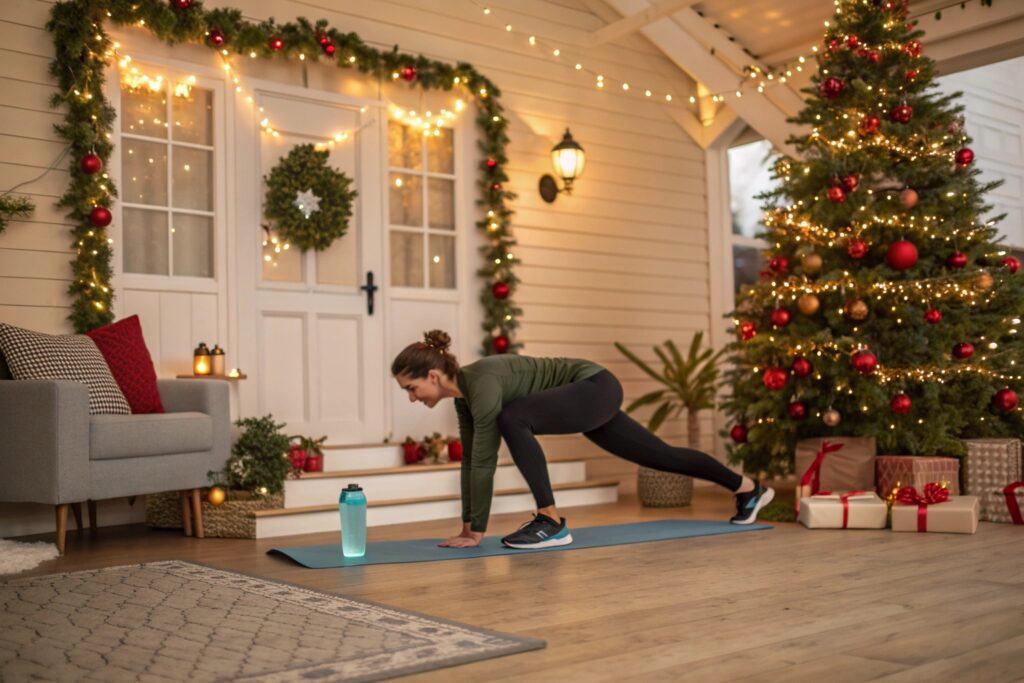Introduction
The Holiday Survival Workout: Stay Fit During the Festive Season – it sounds like a tall order when your calendar is filled with family gatherings, travel plans, and endless plates of holiday treats. Yet staying active during December doesn’t have to feel like a chore. In this guide we’ll blend science‑backed strategies, real‑world examples, and practical tools so you can enjoy the festivities while protecting your fitness goals. Whether you’re a seasoned gym‑goer or a beginner looking for a gentle re‑entry, the Holiday Survival Workout will give you the confidence and structure to keep moving, manage stress, and avoid the dreaded “holiday weight gain.”
Below you’ll discover a step‑by‑step plan that fits into even the busiest holiday schedule, plus tips on nutrition, mindset, and recovery that keep you on track through every celebration.
Section 2 – Understanding the Holiday Fitness Challenge
Why the festive season is a “danger zone” for health
The transition from November to January is statistically the period when adults gain the most weight—an average of 0.5–2 kg, according to a 2022 CDC analysis of more than 15,000 participants. The culprits are plentiful: higher caloric intake from rich dishes, reduced daylight affecting sleep cycles, and a natural dip in motivation after a year of disciplined training. Moreover, the American Heart Association reports a 30 % decline in daily step counts during the holidays, largely because people substitute outdoor walks with indoor gatherings. Recognizing these trends helps you anticipate the pressure points—food, fatigue, and social expectations—so you can proactively build a mitigation strategy rather than reacting after the fact.
The physiology of stress‑eating and how exercise counters it
Holiday stress triggers the release of cortisol, a hormone that not only heightens appetite for sugary, high‑fat foods but also promotes the storage of visceral fat. Regular aerobic activity, such as a 20‑minute brisk walk, can blunt cortisol spikes by up to 25 % (Harvard Medical School, 2021). Resistance training adds another layer of protection: it stimulates muscle protein synthesis, which raises resting metabolic rate by 5–10 % for 24–48 hours post‑workout. By integrating short, high‑intensity interval training (HIIT) sessions into your schedule, you not only burn calories during the workout but also sustain an “afterburn” effect—known as excess post‑exercise oxygen consumption (EPOC)—that continues to oxidize fat well into the night. Understanding this science equips you with a clear rationale for prioritizing movement, even when the couch looks tempting.
Section 3 – Building Your Holiday Survival Workout Blueprint

Design a flexible 4‑day split that works around parties
The cornerstone of a sustainable holiday routine is flexibility. A simple 4‑day split—Monday: upper‑body strength, Tuesday: HIIT cardio, Thursday: lower‑body strength, Saturday: mobility & recovery—fits neatly around typical social calendars. Each session lasts no more than 45 minutes, using bodyweight, dumbbells, or resistance bands you can pack in a suitcase. For example, a Monday upper‑body circuit might include: push‑ups (3 × 12), renegade rows with a kettlebell (3 × 10 each side), and shoulder taps (3 × 20). This format delivers a balanced stimulus while leaving Wednesday and Friday open for holiday events or family meals.
Incorporate “micro‑workouts” to bridge gaps between celebrations
When a full session feels impossible—say, you’re stuck at a relative’s house—a 5‑minute micro‑workout can keep your muscles firing. The “3‑2‑1” routine, recommended by the National Academy of Sports Medicine (NASM), consists of three rounds of: 30 seconds of jumping jacks, 20 seconds of squat pulses, and 10 seconds of plank holds. Completing this sequence three times burns roughly 150 calories and restores metabolic momentum, preventing the “all‑or‑nothing” mindset that often leads to missed workouts altogether. Keep a printed card or phone note with the steps, and remind yourself that consistency—rather than perfection—is the true driver of holiday fitness success.
Leverage active holiday traditions for extra calorie burn
Not all holiday customs have to be sedentary. Turn the ritual of decorating the tree into a strength‑building activity by doing calf raises while hanging ornaments, or add a set of lunges between batches of cookies. A winter walk after dinner not only aids digestion but also aligns with the World Health Organization’s recommendation of 150 minutes of moderate‑intensity activity per week. For families with children, a “snow‑shoe scavenger hunt” or indoor “dance‑off” can double as cardio and bonding time. By re‑framing familiar traditions as movement opportunities, you weave fitness seamlessly into the festive narrative, making the Holiday Survival Workout feel less like a chore and more like part of the celebration.
Section 4 – Comparing Training Modalities: What Works Best During the Holidays?
HIIT vs. steady‑state cardio: efficiency and calorie burn
High‑Intensity Interval Training (HIIT) typically burns 8–15 % more calories in a 20‑minute session than steady‑state cardio of the same duration, according to a 2023 meta‑analysis in Sports Medicine. The intermittent bursts of effort elevate heart rate quickly, creating a larger EPOC effect—perfect for busy holiday weeks when you have limited time. However, steady‑state activities such as a brisk 30‑minute walk are gentler on joints and can be performed outdoors, providing the added benefit of vitamin D synthesis during shorter daylight hours. The best approach is a hybrid: schedule HIIT on days when you have the energy for intensity, and reserve steady‑state cardio for recovery days or family outings.
Resistance training vs. bodyweight circuits: equipment considerations
If you have access to a home gym or a hotel fitness center, traditional resistance training with dumbbells or kettlebells offers precise load progression, crucial for preserving muscle mass during caloric fluctuations common in holiday feasts. Nevertheless, bodyweight circuits are equally effective for maintaining strength and can be executed anywhere. A classic circuit—push‑ups, Bulgarian split squats, mountain climbers, and glute bridges—targets all major muscle groups and can be scaled by altering tempo or adding a backpack for extra resistance. Studies published in The Journal of Strength and Conditioning Research (2022) demonstrate that a well‑structured bodyweight routine can produce hypertrophic gains comparable to light free‑weight training when performed with sufficient volume and progressive overload.
Mind‑body modalities: yoga and mindfulness for stress mitigation
Physical exertion alone does not fully address holiday stress. Incorporating a 10‑minute yoga flow or guided breathing session each evening can lower cortisol by up to 20 % (International Journal of Behavioral Medicine, 2021). Poses such as “Child’s Pose,” “Cat‑Cow,” and “Standing Forward Fold” release tension in the neck and lower back—areas often tightened by hours of gift‑wrapping and cooking. Coupled with a gratitude journal, these mind‑body practices enhance mental resilience, making it easier to make healthier food choices and stick to your workout schedule. The synergy of movement and mindfulness forms a cornerstone of the Holiday Survival Workout, ensuring you stay both physically and emotionally balanced throughout the season.
Section 5 – Practical Tools, Apps, and Step‑by‑Step Implementation
Technology that tracks progress without adding pressure
Fitness trackers like the WHOOP Strap or Apple Watch can monitor heart‑rate variability (HRV), giving insight into recovery status after holiday indulgences. When HRV dips, the device suggests a lighter activity—perfect for listening to your body when you’re low on sleep. For those who prefer a phone‑based solution, the free app FitOn offers holiday‑themed HIIT and strength classes that require minimal equipment. Pairing these tools with a simple spreadsheet—columns for date, workout type, duration, and perceived effort—creates a visual log that reinforces accountability without feeling punitive.
Step‑by‑step weekly schedule (example)
Monday – Upper Body (45 min): Warm‑up (5 min dynamic stretches), circuit (4 rounds: 12 dumbbell bench presses, 10 renegade rows, 15 shoulder taps), cool‑down (5 min foam rolling).
Tuesday – HIIT (20 min): 5 min warm‑up jog, 30‑seconds sprint/30‑seconds walk x 10, 5 min stretch.
Wednesday – Active Recovery (30 min): 15‑minute yoga flow + 15‑minute brisk walk.
Thursday – Lower Body (45 min): Goblet squats, Romanian deadlifts, walking lunges, single‑leg glute bridges (3 × 12 each).
Friday – Free Day: Light activity (e.g., dancing to holiday music) or rest.
Saturday – Mobility & Core (30 min): Plank variations, bird‑dog, hip‑circles, foam‑roll hips.
Sunday – Family Fun: Snowshoe trek, ice‑skating, or a festive obstacle course.
This template can be shifted around to accommodate travel or special events, ensuring you never miss more than two consecutive days of activity.
Nutrition hacks that complement the workout
Timing your meals around your training maximizes performance and recovery. Aim for a protein‑rich snack (15–20 g) within 30 minutes post‑exercise—Greek yogurt with a sprinkle of cinnamon or a whey shake with almond milk works well. During holiday parties, prioritize fiber‑filled vegetables on your plate; they slow carbohydrate absorption and help prevent blood‑sugar spikes. Hydration is another overlooked factor: the National Academies report that a 2‑liter water intake improves cognitive function by 10 %—critical when navigating crowded malls or remembering gift lists. Finally, practice “mindful tasting”: savor each bite for 20 seconds, which can reduce overall intake by up to 15 % according to a University of Pennsylvania study.
Section 6 – FAQs, Troubleshooting, and Final Takeaways
FAQ 1: “I’m traveling across time zones—how do I keep my routine?”
Adjust your workout clock to the new local time within the first 24 hours. Use the “portable HIIT” protocol (bodyweight squats, push‑ups, high‑knees) that requires only a small space and no equipment. Set a reminder on your phone for the same “training window” each day; consistency in timing helps regulate circadian rhythms and mitigates jet‑lag fatigue, keeping you energized for both workouts and holiday celebrations.
FAQ 2: “What if I feel guilty skipping a workout to attend a family dinner?”
Guilt often stems from an all‑or‑nothing mindset. Reframe the situation: a 30‑minute walk after dinner still counts as moderate activity and aids digestion. If you truly can’t move, prioritize a nutrient‑dense meal—lean protein, colorful vegetables, and a modest portion of starchy carbs—to keep insulin stable. Remember that a single missed session won’t derail months of progress; the Holiday Survival Workout emphasizes long‑term habit formation over short‑term perfection.
FAQ 3: “Can I lose weight during the holidays, or should I just focus on maintenance?”
Both objectives are realistic with proper planning. If weight loss is a priority, create a modest daily calorie deficit of 250–500 kcal—enough to lose 0.2–0.5 kg per week without sacrificing energy for festivities. Combine this with the strength‑focused schedule outlined above to preserve lean muscle. If maintenance feels more sustainable, focus on keeping activity levels at least at baseline (≈150 min/week) and practice portion control. In either case, tracking progress through a simple log or app can provide objective feedback and keep motivation high.
Conclusion & Call to Action
The Holiday Survival Workout: Stay Fit During the Festive Season isn’t a rigid program; it’s a adaptable framework that respects the joy, tradition, and inevitable chaos of the holidays while safeguarding your health. By understanding the science behind stress‑eating, leveraging short but potent workouts, and using technology to stay accountable, you can celebrate without compromise. Ready to claim your fitness momentum this December? Start today by choosing one micro‑workout from the list and share your experience in the comments below. Invite friends to join the challenge, and don’t forget to explore our related articles on “Healthy Holiday Recipes” and “Mindful Gift‑Giving for Wellness.” Together, we’ll finish the year stronger, happier, and fully prepared for the new‑year’s goals.



